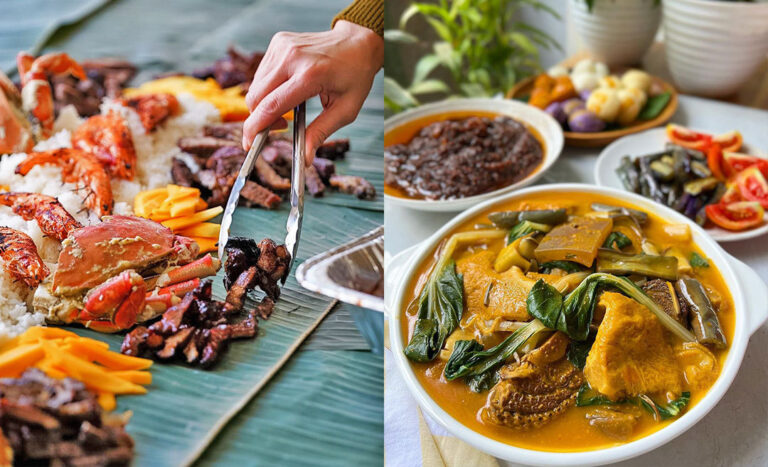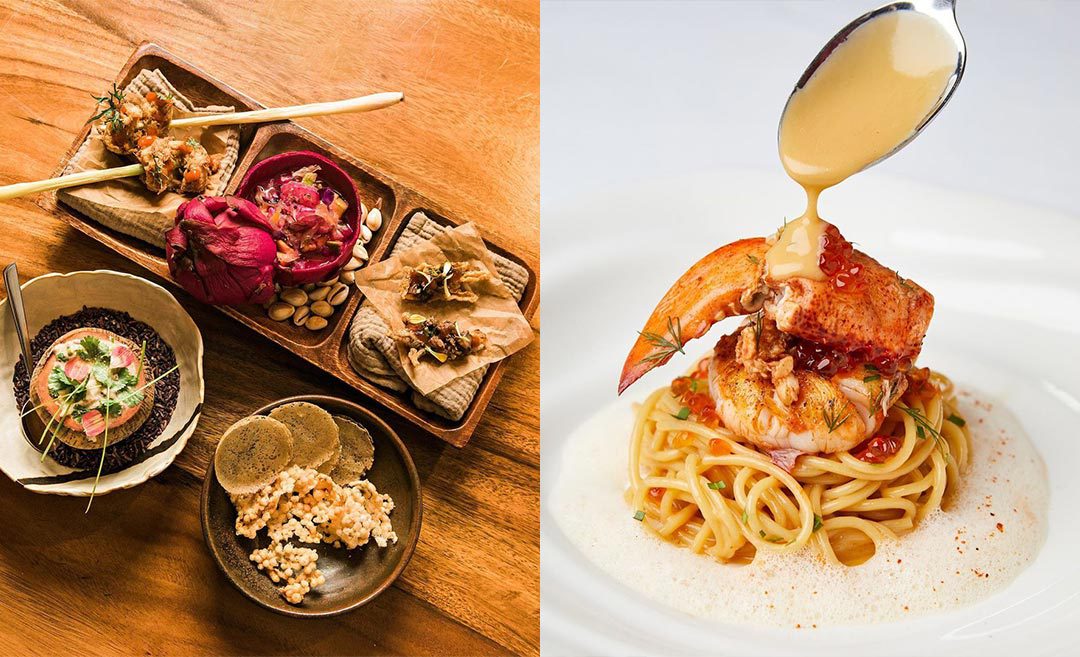For those accustomed to spicy Southeast Asian cuisine, Filipino food offers a more muted experience for the palate. What it lacks in spices, however, it makes up for in richness of flavour. Filipino cuisine encompasses the culinary traditions of more than 100 ethnolinguistic groups. Coupled with strong culinary influences from Spain and the United States, and significant culinary inputs from China, you get a multidimensional and multicultural cuisine.
In this article, we’ll explore 10 of the most iconic Filipino dishes. We’ll also point you to some of the best places in the Philippines and Kuala Lumpur (KL) to sample them.
1. Adobo
One of the best-known Filipino dishes internationally (aside from Jollibee’s Chickenjoy), adobo consists of meat, seafood, or vegetables marinated in soy sauce, vinegar, black peppercorns, bay leaves, and garlic. This marinade results in a rich umami flavour.
There are numerous variations of adobo throughout the Philippines, and many households have their personalised take on the dish. Some of the most common interpretations include adobong manok (chicken adobo), adobong baboy (pork adobo), and adobong baka (beef adobo).
Best places to try adobo: If you’re looking for something more upscale, Romulo Cafe is legendary for its twice-cooked chicken and pork adobo. Via Mare, another upscale chain with branches throughout Metro Manila, offers its own version of the same dish. For those based in KL, consider heading to The Narra in Petaling Jaya to sample this dish.
2. Lechon
The Filipino version of the roasted pig, lechon, is a staple during fiestas, holidays, and other celebrations. There are two main versions of lechon preparation: the ‘Manila lechon‘ and the ‘Cebu lechon‘. Both versions differ in their cooking methods, stuffing, and sauces. When prepared correctly, the cooked skin should be both crispy and flavourful, while the meat should be tender and juicy.
Best places to try lechon: If you’re in Cebu or Manila, check out Rico’s Lechon, where patrons can choose between the original or spicy version. Other standouts are Bai’s Boneless Lechon Cebu and Lydia’s Lechon. KL-ites can head on over to The Narra in Petaling Jaya to try this tasty dish.
3. Tapsilog
Treasured as both a breakfast dish and comfort food, tapsilog consists of garlic fried rice, fried egg, and beef tapa. Tapa is prepared by curing thin slices of beef in salt and spices, resulting in a complex amalgam of flavours. Other side dishes of tapsilog include atchara (pickled and grated unripe papaya) and sliced vegetables (like tomatoes and cucumbers).
Best places to try tapsilog: Popular chains in the Philippines that cater to the masses include Tapa King and Rufo’s Famous Tapa. Upmarket establishments — like Poco Deli and Mary Grace Café — serve a more refined version of the dish (Poco Deli serves steak tapa, and Mary Grace serves sirloin beef tapa).
4. Sinigang
Widely considered to be one of the Philippines’ greatest contributions to world cuisine, sinigang is a wholesome stew characterised by its savoury and sour taste. The most commonly used souring agents include tamarind, unripe mangoes, and calamansi. This sourness is complemented by the addition of briny fish sauce (known locally as patis).
Sinigang typically incorporates meat or seafood with tomatoes, tamarind, garlic, onions, and other vegetables. Chefs have also created veganised versions of the sinigang. This dish is best enjoyed with steaming white rice and more patis.
Best places to try sinigang: Corazon Restaurant serves Sinigang na Hipon sa Sampalok (sinigang with shrimp and tamarind). Abe, which has branches throughout Metro Manila, serves Sinigang sa Ube (sinigang with purple yam), while Romulo Café serves Sinigang na Salmon sa Miso (sinigang with salmon and miso). Mabuhay Laguna Restaurant in KL also serves a hearty sinigang.
5. Kare-kare
Another delicious stew, kare-kare, is made from thickened peanut sauce. The meat base usually consists of beef tripe, pork hocks, beef meat, or oxtail. A medley of vegetables — including okra, eggplant, and green beans — are added to the stew. Other variations of kare-kare incorporate seafood or are exclusively vegan.
Kare-kare is best enjoyed with freshly-cooked white rice, salty bagoong (the Filipino version of fermented shrimp paste), and a squirt of calamansi.
Best places to try kare-kare: Romulo Cafe serves a version with oxtail and tripe. Locavore and Tipsy Pig also serve exceptional versions of the dish.
6. Halo-halo
Best consumed during the scorching midday or warm summer months, halo-halo is a cold dessert made from crushed ice, evaporated or coconut milk, and other ingredients — including thick ube jam, sweet beans, sago, ice cream, and coconut strips. It’s then topped with a scoop of ube ice cream and a small slice of leche flan. Halo-halo is similar to cendol and is just as delicious and refreshing.
Best places to try halo-halo: In the Philippines, there are fast food versions of halo-halo at Icebergs and Chowking. The slightly more upmarket Max’s Restaurant serves great halo-halo with ube ice cream and creamy flan. Pretty much all Pinoy restaurants in KL serve this.
7. Leche flan
The Philippines’ version of the crème caramel, leche flan is richer than the Spanish version (known as flan de leche) since it’s made with condensed milk and more egg yolks.
Leche flan is usually steamed in an oval-shaped mould called llanera to achieve a pudding-like consistency. A sponge cake version of this dessert, known as leche flan cake, is also consumed during merienda (afternoon tea).
Best places to try leche flan: Conti’s, a popular upscale bakeshop in the Philippines, serves this dessert. Via Mare and Manam Comfort Filipino also serve this creamy confection. In KL, Mabuhay Laguna Restaurant serves a mean version too!
8. Boodle fight
Also known as kamayan (literally ‘eating with the hands’), boodle fights are elaborate feasts that bring communities together. Copious amounts of food are arranged on banana leaves and eaten by guests without utensils (similar to banana leaf rice).
The rice is typically steamed white rice, though other variations include rice cooked in coconut leaves and garlic rice. The viands on offer include barbecued meat (inihaw); Spanish sausages flavoured with spices (longganisa); seafood (like crabs and bangus); fresh, blanched, or stir-fried vegetables; and spring rolls (lumpia). Desserts include mangoes, leche flan, and rice cakes.
The best way to enjoy a kamayan is to get invited to a Filipino fiesta or celebration. Not only will you enjoy the company of others, but you’ll also get to truly savour Pinoy dishes by eating with your bare hands.
Best places to try the boodle fight: If you’re in Metro Manila, consider checking out Blackbeard’s Seafood Island in Manila, Tata Boy’s Boodle Fight in Pasig City, or Boodle Fight Manila in Quezon City. The Narra in PJ also has a pretty mean boodle fight on offer.
9. Crispy pata
This pork dish consists of deep-fried pig trotters or knuckles and is typically enjoyed with rice, atchara, and a soy sauce-based dipping sauce. Another popular variant of the crispy pata is the boneless pata. This cut retains more of the pig’s collagen, creating a chewy and delicious texture when deep-fried.
Best places to try crispy pata: Consider dining at Sentro 1771 or Fely J’s in Metro Manila if you want to sample some great crispy pata. Check out Mabuhay Laguna Restaurant if you’re in KL and looking to try this dish.
10. Rellenong bangus
Stuffed dishes in the Philippines are known as ‘relleno‘. Rellenong bangus consists of the skin of the milkfish stuffed with minced milkfish, raisins, ground pork, potatoes, carrots, spices, pickles, and capsicum. The preparation process is rather painstaking since it involves separating the skin from the fish, deboning the meat, and then flaking it.
Next, the skin is marinated while the flaked meat is cooked with all the side ingredients and spices. Finally, the skin is stuffed with cooked meat and fried. Due to its expensive ingredients and complex preparation process, rellenong bangus is best served on special occasions.
Best places to try rellenong bangus: Via Mare is renowned for its rellenong bangus, served with a savoury tomato sauce. If you’re planning a get-together, Goldilocks offers baked large rellenong bangus (large enough to serve 10 to 12 people). The Narra in PJ also serves this special dish.




